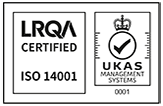Loading a skip properly saves time and money, maximises space and ensures the safety of anyone using it or who comes near it. Knowing how to correctly load a skip streamlines the disposal process, minimises the risk of accidents during transportation and facilitates a smooth and effective clean-up of your site. By following correct loading methods, including observing personal safety procedures, you can optimise skip capacity and comply with current safety regulations.
How to efficiently fill a skip:
Follow our step-by-step guide for the best way to load a skip and ensure efficient waste disposal:
Step 1: Choose the right skip
Selecting the appropriate skip size for your project is key. Assess the volume and type of waste you need to dispose of to select a skip that fits your needs. Consulting with an experienced skip hiring company will help you to secure the right size and avoid overloading, spillages and potentially extra costs and accidents.
Find the best skip size for your needs here
Step 2: Break down large or bulky items
To optimise space, dismantle large or bulky items before loading them into the skip. Break down furniture, flatten cardboard boxes and cut up long pieces of wood. This not only creates more room but also allows for more efficient distribution of waste to avoid overfilling.
Step 3: Layer and distribute waste evenly
Start by placing flat and heavy items at the bottom of the skip to create a solid base. Then, layer smaller and lighter items on top, filling gaps as you go. Distribute the weight evenly throughout the skip to prevent it from tipping over or becoming unbalanced during transport. Compact items wherever possible to make the most of the available space.
By following these steps, you can efficiently fill a skip, ensuring maximum use of space and maintaining safety standards.
How to protect yourself and others
Ensuring safety while filling a skip is very important. By following safe lifting practices, using the appropriate equipment and properly handling of materials, you can protect yourself and others.
Safe lifting practices: how do you get heavy items into a skip?
When lifting heavy items, use proper techniques to prevent injury. Start by assessing the weight of the item and ensure you have a clear path to the skip. Bend at your knees, not your waist, and keep the item close to your body as you lift. Use your legs to lift, never your back. If an item is too heavy to lift alone, seek help or use equipment, such as trolleys or wheelbarrows, to transport it to the skip. Always be mindful of your surroundings and avoid lifting in awkward positions.
Personal Protection Equipment (PPE)
Wearing the right PPE can significantly reduce the risk of injury. Always wear sturdy gloves to protect your hands from sharp objects, rough surfaces and harmful substances. A facemask is essential when dealing with dust, mould or any hazardous particles to prevent inhalation. Depending on the type of waste, additional PPE, such as safety goggles, steel-toed boots and high-visibility clothing, may also be necessary.
Handling unsafe materials: what shouldn’t you put in a skip?
Certain materials should never be placed in a skip due to their hazardous nature. These include:
- Asbestos
- Batteries
- Chemicals and solvents, including Persistent Organic Pollutants (POPs)
- Medical waste
- Paints and varnishes
- Gas cylinders
- Electrical appliances
- Fridges and freezers
- Tyres
Handling and disposing of these materials requires special procedures to ensure safety. Always check with your skip hire company for a comprehensive list of prohibited items and follow their guidelines. If you encounter potentially unsafe materials, contact professional disposal services to manage these items properly.
How high should you fill a skip?
Understanding and not exceeding the optimal fill level for your skip is crucial to ensuring safe and efficient waste disposal.
How to avoid overfilling your skip
It’s essential to avoid overfilling your skip for several reasons. Overfilling can make it unsafe to transport, as items may fall out during transit, posing a hazard to others on the road. Additionally, skip hire companies typically have strict guidelines on how high skips can be filled for safety and legal reasons. Exceeding these limits may incur additional charges or refusal to collect the skip.
To prevent overfilling, ensure that waste is level with the top edges of the skip. Avoid piling waste above the rim or sides, as this can lead to spillage and potential accidents. If you have excess waste, consider hiring an additional skip or arranging for an extra collection.
Types of waste that can go in the skip
Skips are suitable for various types of non-hazardous waste generated from home renovations, construction projects, garden clearances and more. Common types of waste that can be disposed of in a skip include:
- General household waste (excluding hazardous materials)
- Construction and demolition debris, such as bricks, rubble and tiles etc.
- Garden waste, including soil, branches and grass clippings
- Inert materials, such as concrete and asphalt
- Packaging materials, such as cardboard and plastic
Always check with your skip provider regarding specific items or materials they will and will not accept to avoid any complications during disposal or incurring additional costs. Sorting waste beforehand can help streamline the loading process and ensure compliance with skip regulations.
Reducing wasted space and potential safety risks
From choosing the right skip size to handling materials responsibly, following these simple steps and our advice on avoiding personal injury will enable you to optimise waste disposal, minimise costs and keep everyone safe.
Find out more about our wide range of skips available to hire here
Rabbit Skip Hire:
Rabbit Skip Hire is an established and expert supplier of skips for commercial and domestic projects of all sizes throughout East and West Sussex.
To find out more about Rabbit Skip Hire’s reliable and expert skip hire contact our expert and friendly team on 01903 762020, email info@rabbitgroup.co.uk or fill out our online skip hire contact form.
Rabbit Skip Hire is part of Rabbit Waste Management, which includes Rabbit Demolition.





